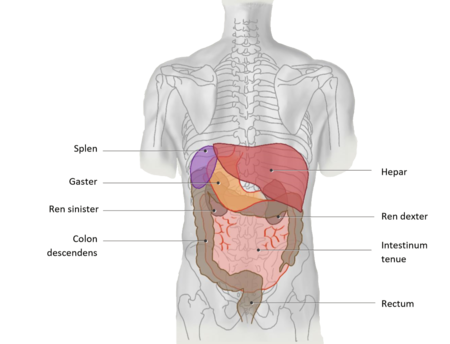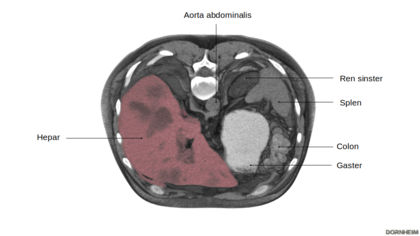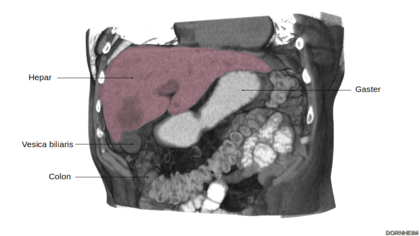Liver (Hepar)
The liver is the largest digestive gland in the human body. Due to its function and tasks it is the central organ of metabolism. It forms important proteins and detoxifies the body. Almost all nutrients that are absorbed through the intestines are first passed through the liver.
Inhaltsverzeichnis
Anatomy
Projection
The liver is located in the right upper abdomen but extends beyond the epigastrium into the left upper abdomen. It is pushed far in front of the stomach, which leaves an imprint (Impressio gastrica) at the back of the left lobe of the liver. The right lobe of the liver comes into close contact with the large intestine (right flexure), the small intestine (pars superior), the upper part of the right kidney and the right adrenal gland. Their imprint sites are also named accordingly: Impressio colica, duodenalis, renalis and suprarenalis. The position of the liver is strongly dependent on breathing, as its underside is fused with the diaphragm. Age and posture are also decisive for the position of the liver. The gallbladder lies dorsally between the left and right lobe of the liver.
Liver in situ
The thin area of tissue between the liver and the curvature of the stomach is called omentum minus. This serous skin coats the peritoneal cavity and is the ventral boundary of the bursa omentalis. It is bordered on the right side by the liver.
The downward pointing edge of the liver is sharp-edged and easy to palpate in an enlarged liver. The liver extends from the right hypochondriac region via the epigastric region to the left upper abdomen. The stomach is visible at the lower left border of the liver. The gallbladder is located on the underside of the liver and protrudes above the lower edge of the liver.
Liver segments
The liver segments are formed by a total of 8 functional subunits of the liver. Each of these units has a branch of the portal vein, the bile duct and a segment branch of the arteria hepatica propria.
Assignment to Partes and Divisiones
| Pars hepatis sinistra | |
|---|---|
| Segment I | Pars posterior hepatis, Lobus caudatus |
|
Divisio lateralis sinistra |
| Segmentum mediale sinistrum (= Segmentum IV) subdivided into segment IVa and IVb |
Divisio medialis sinistra |
| Pars hepatis dextra | |
|---|---|
| Segmentum anterius mediale dextrum (= Segmentum V) Segmentum posterius mediale dextrum |
Divisio medialis dextra |
| Segmentum anterius laterale dextrum (= Segmentum VI) Segmentum posterius laterale dextrum |
Divisio lateralis dextra |
Since each subunit has its own supply route, the liver segments can be removed individually by surgery. The liver is still functional after the removal of a subunit, as are the removed subunits themselves. This makes a partial implantation of a liver possible.
Different views
| Dorsal view of the pars superior of the facies diaphragmatica | View from ventral to the facies diaphragmatica | View from caudal on the facies visceralis |
| Most of the liver surface is surrounded by visceral peritoneum. However, the area nuda is the only one that remains peritoneally free; its surface forms the connective tissue capsule. Outside the peritoneal cover the usually three Vv. hepatica leave the liver. A special feature of the liver is that in the liver, only the incoming artery and the incoming V. portae hepatis and Ductus choledochus run in the mesohepaticum, but not the outgoing veins. At the points of transition from the visceral to the parietal peritoneum on the underside of the diaphragm, the connective tissue peritoneal epithelium appears as
"Strang" (Lig. coronarium). From this connective tissue structure a small tip (Appendix fibrosa hepatis) develops on the left lobe of the liver. |
From the ventral view, the two liver lobes, the large lobe hepatis dexter and the smaller lobe hepatis sinister, are clearly visible. The Lig. falciforme hepatis runs between the two lobes. The Ligamentum falciforme hepatis forms the Mesohepaticum ventrale and thus the connection between liver and abdominal wall. |
The caudal view allows a view of two more of the four liver lobes: the caudatus and the quadratus hepatis. The Lig. hepatoduodenale serves the liver together with the Lig. hepatogastricum as Mesohepaticum dorsale and belongs topographically to the Omentum minus. The gallbladder towers above the lower edge of the liver with the fundus and lies closely to the facies visceralis. The neck of the gallbladder points to the hepatic portal where it comes into contact with the extrahepatic bile ducts. |
Function
As the largest and most important metabolic organ, the liver has various tasks in the human body. It produces vital proteins and is significantly involved in the utilization of food components as well as the breakdown and excretion of substances.
Diseases
<segmenter>https://dornheim.cloud/index.php/apps/segmenter/embedding/view?identifier=UfUm4eWaRri1</segmenter>



